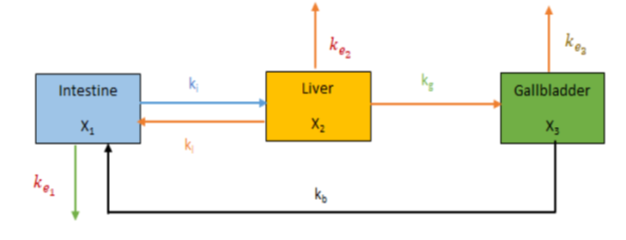


Indian Journal of Science and Technology
Year: 2021, Volume: 14, Issue: 18, Pages: 1422-1433
Original Article
Ramanamoorthy Kandula1*, Rupali S. Jain2, Sandhya Kandula3, B Surendranath Reddy2
1Assistant Professor, Department of Mathematics, B V Raju Institute of Technology, Narsapur-502313, Medak-Dist. T.S, India. Tel.: +91-984-992-8294
2Assistant Professor, Department of Mathematics, Swami Ramanand Teerth Marathwada
University, Nanded-431606, M.S, India.
3Assistant Professor, Department of Pharmacology, Vishnu Institute of Pharmaceutical
Education and Research, Narsapur-502313, Medak-Dist., T.S, India.
*Corresponding Author
Tel: +91-984-992-8294
Email: [email protected]
Received Date:13 March 2021, Accepted Date:04 May 2021, Published Date:18 May 2021
Objectives: To design a bio-compartmental model of enterohepatic circulation; and to estimate the concentration of bile acid in a different compartment and to understand the various pathological states connected to bile concentration. Methods: The model is based on parameters of volume of bile juice, the mass of bile acid, and the rate of bile secretion in all compartments. The model estimates various clinical manifestations of gallbladder and intestine describing the variable concentration of bile acid based on pathological state and application of mathematical simulation of fractional derivative (MATLAB). Findings: Compatibility of the model results considering pathological data allows us to estimate bile acid concentration in different pathological conditions, thus alters the physiology of enterohepatic circulation. Based on a pathological case the bile acid concentration was estimated and then the fractional derivative was applied to understand the severity of bile-related disorder with the help of mathematical simulation. The graphical results are obtained by applying fractional-order derivative (A Caputo sense) in different pathological cases depicts the varying bile acid concentration in the intestine, liver, and gallbladder comparative to a normal concentration. All findings clearly mentioned in section 4 (Results and Discussion). Novelty/Applications: Mathematical simulation of deposition of bile acid in conjugation with enterohepatic circulation, compartment model helps to understand the pathological disorder and etiology with the clinical symptoms of bile secretion.
Keywords: Intestine; Gallbladder; Liver; Enterohepatic circulation; Bile acid concentration; Mathematical modeling.
© 2021 Kandula et al.This is an open-access article distributed under the terms of the Creative Commons Attribution License, which permits unrestricted use, distribution, and reproduction in any medium, provided the original author and source are credited. Published By Indian Society for Education and Environment (iSee)
Subscribe now for latest articles and news.